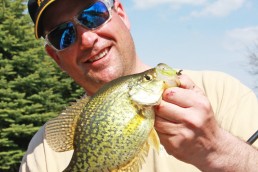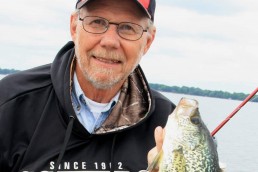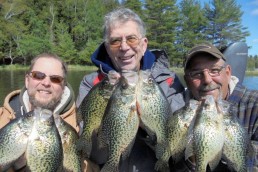Summer Vegetation Crappies
SHARE THIS POST
Summer weeds can project two images in our minds. One is having fun pulling fish from weed hideouts. The second is one of constant hang-ups, stringy stuff hanging from hooks and constant frustration to in bait presentation. There is often a happy medium for successfully catching fish.
Lily pads
The lake determines the type of vegetation. Clearer waters have the most vegetation. Clear, shallow Reelfoot Lake in Tennessee is known for it’s massive amounts of lily pads. They are easy to find by looking across the lake.
“Younger to mature pads provide great action in spring, but you can catch fish in the summer, too.,” says Louie Mansfield, owner of Grizzly Jig Company, who has a cabin on the lake. “In summer, I like to find the mature lily pads mixed in with the wood stumps. The wood cover, along with the shade from the pads, make them excellent. Places with stumps, duck blinds and trees are top places to look.
“Everything is a straight-up-and-down presentation. Swim the bait a little and the hook will find a pad stem, making it difficult to get out.”
Mansfield uses a 9- to 10-foot Grizzly Elite pole in areas with overhanging tree limbs, but switches to a 12- or 13-footer in open areas.
Fisherman and host of BrushPile Fishing TV, Russ Bailey, says he likes to find small areas of pads on a lake that isn’t full of them. For example, he took me on a trip to a northern lake with an acre or two of pads between two islands.
“Whether fishing far south or far north,” says Bailey, “I find a lot of fish positioned at the base of the pads. We have a misconception that a crappie will only feed up, but they will take a tube bounced off the bottom most of the summer.”
Bailey uses ultra-light presentations with a 10.5-foot BnM Bailey Signature series pole, 6-pound test line and a 1/32-ounce jig dressed with a large Southern Pro tube. He says the large tube with a light head creates a very slow, natural presentation. He uses a small ice float to detect bites. The float also keeps bait at the right depth and allows it to be pitched further from the boat.
More vegetation
Illinois guide Kyle Schoenherr says vegetation can host excellent summer fishing. He uses a 12-foot BnM BGJP jigging pole for pitching to the edges of the weeds. The long pole’s advantage over shorter poles is better control of the bait and better hook-up angle for setting the hook. He uses 15-pound-test Power Pro Braid for a strong line in the weeds. The float is an inexpensive medium-large slip float.
“The weeds here on this lake come out to around seven feet where they are on top. They continue under the water down to 11 or 12 feet. These outside weeds are the ones we’re fishing over and where the fish are holding. Depending upon the slope of the point, these fish might be 60 or 70 feet from shore, in 11 feet of water where the weeds begin. A fisherman has to see it on electronics, so the sonar is important when looking at details.”
Schoenherr says fish will group in certain areas in the weeds. Points are good because the fish usually like them, and they are easy for a fisherman to find.
“I lip-hook a minnow under a slip float. I use heavier jigs or an egg sinker with a minnow. A 1/4- or 3/8-ounce weight under a float gives good control for pitching. I place the sinker close to the hook, about four inches from the minnow, so the minnow doesn’t have room to swim around and get hung in the weeds.”
Are you enjoying this post?
You can be among the first to get the latest info on where to go, what to use and how to use it!
Schoenherr says to leave a bait still for a while because it may take a minute or two before the fish decide to hit. A good strategy is to move along a little faster until a fish is found, then slow down and work the area.
“The good thing about fish in the weeds is that, once you form a pattern, they’ll stay in the pattern for a while. You can usually find them in the same places day after day. Early morning is usually the best time for fishing the weeds.”
Submerged shoreline
I had the opportunity to enjoy a fishing trip in western New York. The crappies were in transition from the spawn to post-spawn periods, so they were toward the banks in four to ten feet of water, stationed on submerged vegetation. Our presentations were simple— casting with a float in shallower water —but we fished it free-fall when crappies were a little deeper. Summer tactics will be identical, but they’ll likely be on the deepest part of the weeds.
The key to the technique is to use electronics to find the weeds, learning how deep they are located in relationship to the bottom. For example, weeds may be a foot tall at 11 feet. Weeds may be three feet tall in seven feet of water, putting the top of the weeds at four feet from the surface. While searching for weeds and depth, pay attention to fish on the locator to learn their depth and relationship to the weeds.
Use ultra-light or light equipment. Baits should be small, 1/32-ounce jigs or small minnows. Use 4- or 6-pound test clear monofilament bin clear waters.
Casting to weed crappies can be exciting and filled with action.
Final tip
Another place to catch crappies is in the grass. On shallow lakes or in large, shallow areas, a summer thermocline may set up extremely shallow. Oxygen will be good in the top layer, making pads, moss and grass outstanding covers.
For more information…
Kyle Schoenherr, fishing guide: 618-314-2967.
Become a MidWest Outdoors Insider here!
MWO
SHARE THIS POST
Did you enjoy this post?
You can be among the first to get the latest info on where to go, what to use and how to use it!
Tim Huffman
Tim Huffman specializes in crappie fishing, is editor for two crappie magazines, as well as writing for several others. In 2018, he published his sixth book, Limiting Out for Crappie, available at Amazon. His first article appeared in MidWest Outdoors in 1988.



